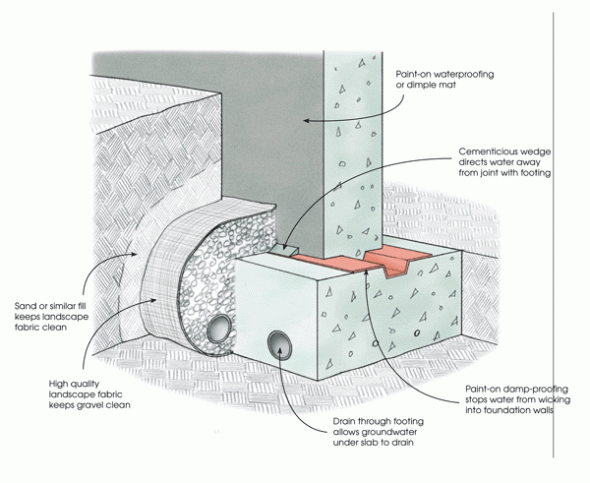
Image Credit: Green Building Advisor
Scott Razzino has an all-too-familiar problem. The basement of his 1,100-sq.-ft. home in Atlanta is chronically damp. He’s installed a 65-pint dehumidifier, which must be emptied every day. Surely, he wonders in this Q&A post, there must be a better way to tackle the problem.
Razzino reports that the house is about 26 years old and has a block foundation. He’s routed gutters away from the house and sealed air leaks in the walls with mortar and concrete sealant. The basement doesn’t have a sump pump.
Short of installing French drains around the house, along with a sump pump, is there anything that can be done?
The first step, says Robert Hronek, is to figure out the source of the moisture. He suggests taping foil to the wall in several spots and waiting to see whether any condensation appears.
“If the water is trapped between the wall and foil, then it is coming through,” Hronek writes. “If there is condensation on the outside of the foil, then the moisture is from air leaks.”
If moisture is migrating through the block, adds Robert Riversong, sealing the surface with two coats of UGL Drylok masonry sealer “will make a major difference.”
The manufacturer claims that Drylok’s breathable film won’t trap moisture in masonry and will withstand 10 lb. of hydrostatic pressure, “greater than a wall of water 22 ft. high.”
“Drylok is the only foundation waterproofer I will use, and it’s excellent for a capillary break between footings and foundation wall on new construction,” Riversong says. “I’ve used it to seal the interior of site-built CMU composting toilet chambers (over surface-bonding cement) as well as the exterior of exposed chimney block.”
Where is the water coming from?
“Concrete-block walls in a wet and humid climate…
Weekly Newsletter
Get building science and energy efficiency advice, plus special offers, in your inbox.

This article is only available to GBA Prime Members
Sign up for a free trial and get instant access to this article as well as GBA’s complete library of premium articles and construction details.
Start Free TrialAlready a member? Log in





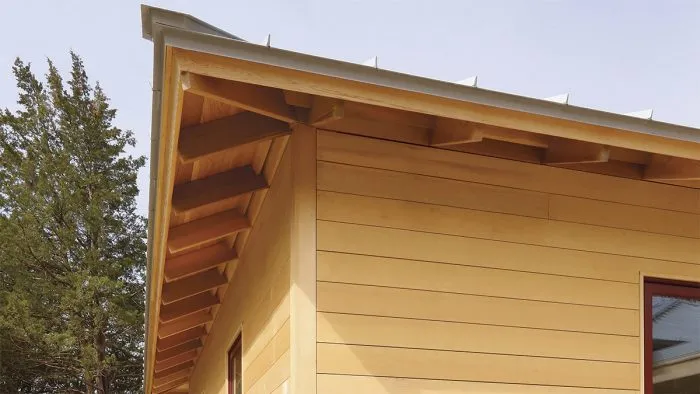
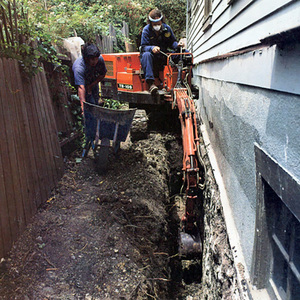
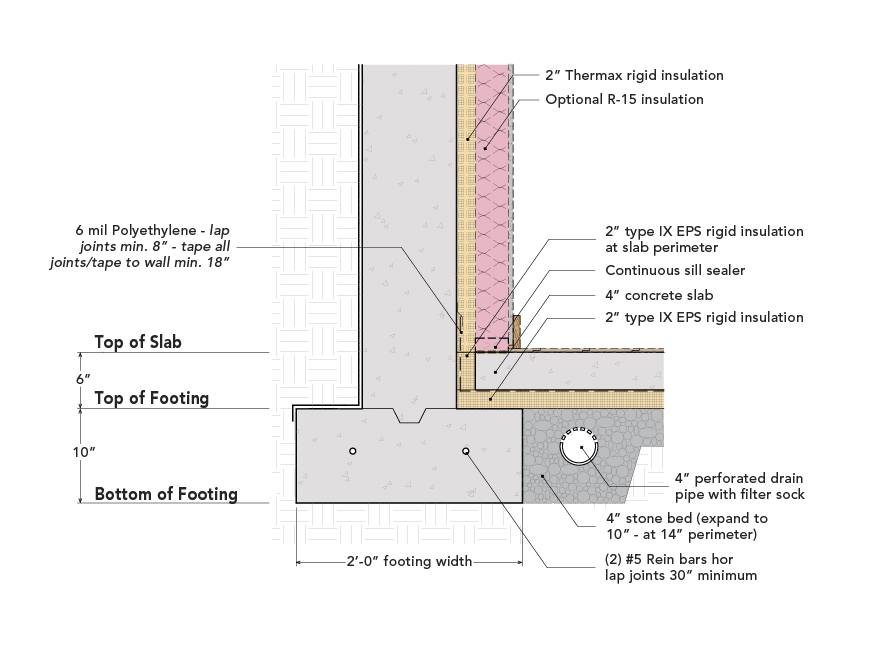
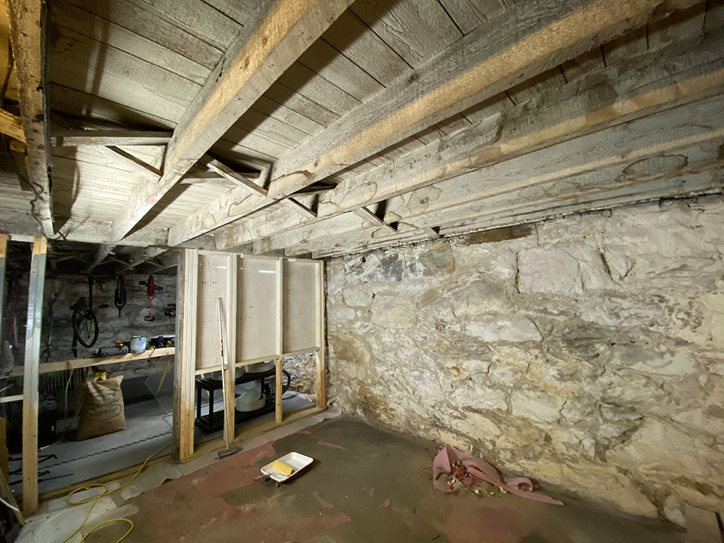






12 Comments
It Depends
There is a lot of Yankee vrs southerner stuff here. You all have very deep frost depths and gravel soil and I guess you must over-dig and form all your footings rather than cut trenches and fill them with concrete with a twelve inch frost depth in heavy clay soil like we have in the South East.
if we were to set our drains next to the footings as you suggest we would have to over dig and form or re-excavate after the footings had been poured. The simple fact is that, while it may be preferable to over-dig and form in order to place the drain adjacent to the footing it really doesn't make any difference in the soils we have in the south east. Placing the footing directly on the waterproofing where it coves out from the foundation wall onto the footing gets the bulk of the water away and relieves the pressure at very low cost. In general we see best value in proper grading at the surface and vigilance about horizontal rock formations below the soil with water lensing (moving horizontally) horizontally on top of them between the rock and the clay.
Things are just different down here. Ventilating the basement or crawl just lets in hot humid air which condenses on the cool concrete and slab floor as well as pipes and AC ducts and makes things wetter. An exhaust fan that pulls conditioned air from the house and exhausts it from the crawl makes more sense than ventilating it with outside air or running an AC supply into the crawl (and returning that air to the house through the return)
James Morgan is right, New England best practices just don't always apply in the South East.
Nor Vice Versa
In the Northeast we know how to install proper foundation perimeter drains because their purpose is NOT to evacuate surface water - that's taken care of with overhangs, gutters, leaders, grading and swales.
In much of New England, seasonal high ground water prevents the installation of in-ground septic systems. That also means that seasonal high ground water may be precariously close to the footing and basement slab level. Perimeter drains are designed to evacuate rising ground water, which is why the holes are on the bottom of the perforated pipe.
So all the above-ground mitigation may not be sufficient to alleviate a wet basement and, just as gutters are preferable to surface drains as a first line of defense, an exterior drain is far preferable to an "after-market" interior drain as the first line of defense against wet basements.
You'll notice in the image I linked to (http://www.hipspro.com/webart/footing-perimeter-french-drain.jpg), there is a relatively impermeable cap layer of soil over the course aggregate backfill so that ground water but not surface water finds its way to the perimeter drain. The course backfill also alleviates hydraulic pressure on the foundation as the soil becomes saturated.
One questionable detail in the foundation drain image at the beginning of this blog post is the transverse drain through the footing. A properly installed perimeter drain should prevent ground water from rising up under the basement slab and the 4"-6" of sub-slab stone will serve as a capillary break, assisting the sub-slab vapor barrier in keeping the concrete floor dry. But, for a radon vent at the inside perimeter of the foundation to function properly, it cannot be tied to an outside perimeter drain to daylight. The radon stack, connected to the inside perimeter piping, is designed to induce a negative pressure under the slab to draw soil gases out. A short-circuit to daylight will undermine this negative pressure zone.
If daylighting of the footing drain is impossible due to flat topography, then a transverse connector through the footing will empty the drain into a gasketed radon-proof sump, which is NOT connected to the interior radon drainpipe or to the subslab stone.
With rectification, as with new construction, the most reliable way to keep a basement dry is to dig out around the foundation to the footings, install a proper perimeter drain, cove the wall/footing joint with hydraulic cement, waterproof the exterior of the foundation, and backfill with well-drained mixed aggregate covered with a soil cap. I did this on a 1965 cape I owned and it effectively stopped what had been a spring-time stream running through the cellar.
"In the Northeast we know how"
Down here we have an expression for Yankees who talk like that.
Retrofits vs. New Construction
Wet basement retrofits vs new construction details just aren’t a fair-fight comparison. No question, that in a perfect world with an open-ended budget, a full exterior excavation with the aforementioned detailing would be a best-case resolution. That’s what I’d want on my house if all the stars-and-moons were aligned in my favor. However, here in the mid-Atlantic, a full excavation project for an average single family home can be $20-$40k pretty commonly. On the other hand, a retro-fitted interior drain tile system can be accomplished for usually less than $10k.
Add to that the difference in safety and logistics for the two options. Our area has had 5 laborers killed in the last four years due to residential retrofit excavation cave-ins. As such, it is on every building and OSHA inspector’s radar screen as soon as they see soil coming out (and rightly so). With the tight lots many of our houses are built on, it can often be impossible to implement the four-foot step-back grading slope requirements for workers’ safety. So then instead the GC has to supply and install trench-collapse boxes. When was the last time anyone saw one of those on a residential site??
Our area also had an incident last year where workers were injured when the old rubble-stone foundation wall collapsed into the trench (not to mention damage to the house). The post-incident report said that it could have been prevented with properly engineered structural-shoring matched with geotechnical soil analysis for shoring support. But once again, how often does that ever happen in residential remodel situations?
While far from perfect, an properly detailed interior retro-fit perimeter drain system is often the best choice; financially, logistically, and time wise. In addition to being far safer, an interior system can be accomplished in 1-3 days depending on the linear footage vs weeks for an exterior project. It also isn’t weather dependent and it won’t tick-off all of your neighbors, unlike many exterior undertakings. It does a great job of relieving the hydrostatic head on the foundation wall, and it efficiently moves the water out-of and away-from the structure.
When combined with either a battery back-up system (most common) or a municipal water-pressure back-up system (my personal preference because it can still run for days during our often prolonged power outages) then it creates a proven track record of dry basements. Like anything, there are plenty of hacks putting these systems in poorly, but the better guys who take their time really get great, long-term results.
As for the UGL product, we also use it. When it’s part of the package solution including a drain system it works like a champ for us. However, in our experience with the mid-Atlantic’s super-compressive clay soils, when it is used by itself without any hydrostatic relief, we only seem to get about 3-5 years out of it before it starts bubbling and delaminating. We’ve even installed it with the factory rep looking over our shoulder just to be certain we were following the guidelines and our soil was still too much for it. We can always tell because the white paint will start turning rust color at the blister marks which is where the clay has driven through the CMU voids and is pressing into the interior. This obviously shows poor (or no) foundation wall treatment on the exterior, but that’s pretty common for a good portion of our pre-1940 housing stock.
Chandler's detail
Michael Chandler- would you mind sharing a sketch of the detail you mentioned:
"Placing the footing directly on the waterproofing where it coves out from the foundation wall onto the footing". Something about that wording isn't clear to me. I'm designing/detailing here in NC too (the western side) and would like to fully understand what you have found successful in our area.
that detail
There are some photo's here that show what I'm talking about. the Footing DRAIN is placed directly on the waterproofing where it coves out from the foundation wall onto the footing.
This is that house we had to work with the appraiser so hard to get financed in this article.
https://www.greenbuildingadvisor.com/blogs/dept/business-advisor/green-building-appraisal-and-financing-issues
oh boy, more ammo for my wife
oh boy, more ammo for my wife and friends for why i should join facebook
wet basements
Leaving aside retrofits for a moment, in all this back and forth no one has mentioned the elephant in the room: basements are mostly for wet spiders and stuff you don't use. Humans are not groundhogs. Why build a basement at all? Slab on grade (and radiant if you can afford it) makes a lot more sense.
detail drawing
just a comment/question:
I continue to see footing/foundation details drawn with a keyway cast in the top of the footing.
I have not seen that detail actually installed in over twenty years, and have never seen it in production building. This engineered connection has been replaced by cast in place rebar.
Is anyone out there including this detail or is it time to start revising these dated drawings?
Insulate It
AFTER you solve the water problem (with Drylok paint, internal drain, sump, external gutters & grading...) take the job to the next step and add insulation. For block walls you can install EPS sheets, say 3" or 6". Install w/ strapping for an attached finish wall - wood or sheet-goods. Air-seal and Insulate the band joist. Paint the slab with Drylok too, or install 1-2" XPS - but then you need a finished floor.
Limestone foundation walls
Our 80-year-old house in Wisconsin has limestone foundation walls. Is the UGL Drylok appropriate for stone walls, or would something else work better with stone?
I moved to Knoxville TN
I moved to Knoxville TN almost two years ago. I have looked at every house for sale in one of the most upscale neighborhoods here (about 40 by now). I can count on one hand the houses that did not have mold problems. Even newer houses with no apparent moisture problems left my wife and I with sore chests after a short time. I can only speak for Knoxville, but mold resulting from poor drainage management is a big problem here.
My solution is to build my own house. When I spoke to the head guy at the main Building Dept., he said the detail he would choose would be to have continuous gravel under both slab and footing, and locate the drain pipe even below the bottom of the footing. He suggests this will prevent excess moisture below the slab and will obviate the need for an interior drain. In my estimation, over-digging the footing will be worth the expense because it will result in a house we can live in.
Log in or become a member to post a comment.
Sign up Log in